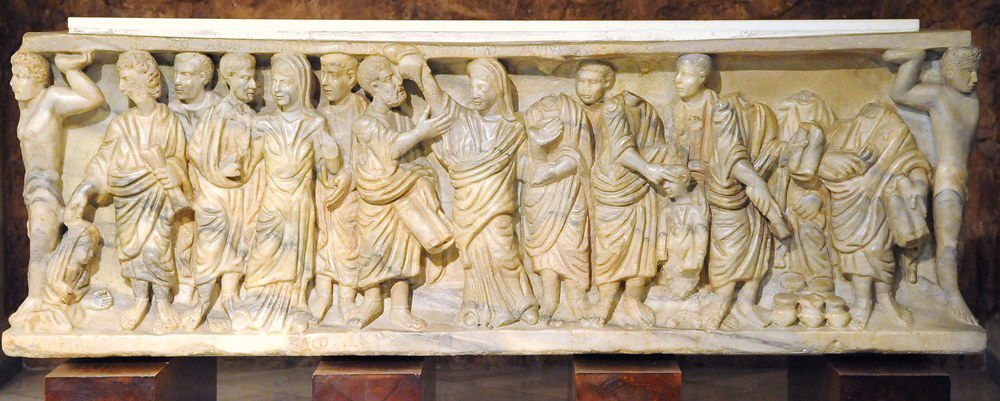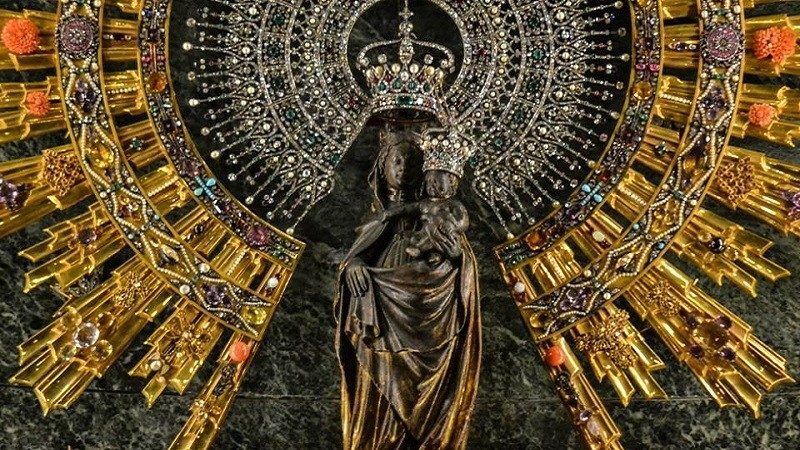Our Lady of Pilar

Feast: October 12th
History of the Virgin of Pilar
The tradition, as it has emerged from some documents of the thirteenth century that are preserved in the cathedral of Zaragoza, dates back to the time immediately after the Ascension of Jesus Christ, when the apostles, strengthened with the Holy Spirit, preached the Gospel. It is said that the Apostle James the Greater, brother of St. John and son of Zebedee, preached in Spain. Those lands had not received the Gospel, so they were bound to paganism. James obtained the blessing of the Blessed Virgin for his mission.
The documents say that Santiago, "passing through Asturias, arrived with his new disciples through Galicia and Castile, to Aragon, the territory called Celtiberia, where the city of Zaragoza is located, on the banks of the Ebro. There Santiago preached many days and, among the many converts, he chose as companions eight men, with whom he dealt with the kingdom of God during the day, and at night, he went along the banks to take some rest".
On the night of January 2, 40, James was with his disciples by the river Ebro when "he heard the voices of angels singing Ave, Maria, gratia plena and saw the Virgin Mother of Christ appearing, standing on a marble pillar". The Blessed Virgin, who was still alive in mortal flesh, asked the Apostle to build her a church there, with the altar around the pillar where she was standing and promised that "this place will remain until the end of time so that the virtue of God may work wonders and marvels through my intercession with those who in their needs implore my patronage". The Virgin disappeared and the pillar remained there. The Apostle James and the eight witnesses of the prodigy immediately began to build a church on that site and, with the help of the converts, the work began rapidly. But before the church was finished, James ordained one of his disciples as a priest to serve it, consecrated it and gave it the title of St. Mary of the Pillar, before returning to Judea.
This was the first church dedicated in honor of the Blessed Virgin. Many historians and researchers defend this tradition and argue that there are a number of monuments and testimonies that prove the existence of a church dedicated to the Virgin of Zaragoza. The oldest of these testimonies is the famous sarcophagus of Santa Engracia, which has been preserved in Zaragoza since the 4th century, when the saint was martyred. The sarcophagus represents, in bas-relief, the descent of the Virgin from heaven to appear to the Apostle Santiago.
Also, around the year 835, a monk of Saint Germain of Paris, called Almoino, wrote some writings in which he speaks of the Church of the Virgin Mary of Saragossa, "where the great martyr Saint Vincent had served in the third century", whose remains were deposited by the bishop of Saragossa, in the Church of the Virgin Mary. It is also attested that before the Muslim occupation of Zaragoza (714) there was a temple dedicated to the Virgin.
The devotion of the people to the Virgin of Pilar is so deeply rooted among the Spaniards and from such remote times, that the Holy See allowed the establishment of the Office of the Pilar in which the apparition of the Virgin of Pilar is consigned as "an ancient and pious belief".
Numerous miracles of the Virgin
In 1438 a Book of miracles attributed to the Virgin of Pilar was written, which contributed to the promotion of devotion to the point that King Ferdinand the Catholic said: "we believe that none of the Catholics of the West is unaware that in the city of Zaragoza there is a temple of admirable sacred and ancient devotion, dedicated to the Holy and Most Pure Virgin and Mother of God, St. Mary of Pilar, which shines with countless and continuous miracles".
The Great Miracle of the Lame Man of Calanda (1640) It is about a man who had a leg amputated. One day years later, while dreaming that he was visiting the basilica of the Virgin of Pilar, the leg returned to its place. It was the same leg he had lost. Thousands of people witnessed it and on the right wall of the basilica there is a painting commemorating this miracle. Pope Clement XII set the date of October 12 as the particular feast of the Virgin of Pilar, but already for centuries before, in all the churches of Spain and among the peoples subject to the Catholic king, the joy of having had the Mother of God in their region, when she was still alive in mortal flesh, was celebrated.
Three peculiar traits that characterize the Virgin of Pilar and distinguish her from the others:
1- It is an extraordinary coming of the Virgin during her mortal life. Unlike the other apparitions, the Virgin comes when she still lives in Palestine: "With no nation did she do such a thing", the liturgy of January 2, feast of the Coming of the Virgin, will rightly sing.
2- The Column or Pillar that Our Lady herself brought so that, on it, the first chapel could be built, which, in fact, would be the first Marian Temple of all Christianity.
3- The linking of the Pilarist tradition with the Jacobean tradition (of the Sanctuary of Santiago de Compostela). Therefore, Zaragoza and Compostela, the Pillar and Santiago, have constituted two fundamental axes, around which the spirituality of the Spanish homeland has revolved for centuries.
Symbolism of the pillar
The pillar or column: the idea of the solidity of the building-church with that of the firmness of the column-trust in Mary's protection. The column is symbol of the conduit that unites heaven and earth, "manifestation of the power of God in man and the power of man under the influence of God". It is the support of the sacred, the support of daily life. Mary, the gate of heaven, Jacob's ladder, was the woman chosen by God to come to our world. In her, earth and heaven were united in Jesus Christ. The pillars guarantee the solidity of the building, be it architectural or social. To break them is to threaten the whole building. The column is the first stone of the temple, which develops around it; it is the axis of the construction that links the different levels.
Mary is also the first stone of the Church, the temple of God; around her, like the apostles gathered on the day of Pentecost, the people of God grows; the faith and hope of the Virgin encourage Christians in their efforts to build the kingdom of God. We see in Ex 13, 21-22, that a pillar of fire by night accompanied the pilgrim people of Israel in the desert, directing their itinerary.
In the Virgin of the Pillar the people see symbolized "the presence of God, an active presence that guides the chosen people through the ambushes of the road".
Eucharistic Liturgy of the Pillar:
The texts used are: in the first reading, 1 Chronicles 15, where the Virgin symbolized by the ark of the covenant is recalled, the presence of God in the midst of his people, through Mary, which is joy for the Church. The second reading (Acts 1:12-14) and the Gospel (Lk. 11:272-28) also speak to us of the presence of the Virgin in the Church and of the praises that the people pay her. The preface celebrates the wonders that God has worked in Mary, "the hope of the faithful and the joy of all our people". During the collect prayer we ask for "strength in faith, security in hope and constancy in love" through the intercession of the Virgin, as well as in the offertory prayer, where the desire to "remain firm in the faith" is expressed. Entrance antiphon: the Virgin is thought of as "the pillar that guided and supported the people day and night in the desert", and in the responsorial psalm it is recalled "the Lord has crowned me, he has exalted me on the pillar". In the alleluia: "he has set my feet upon the rock and put a new song in my mouth". The liturgy is dominated by the idea of Mary's presence in the Church and of the firmness that her intercession and devotion procures for the people of God.
On October 12, 1492, precisely when the three caravels of Christopher Columbus sighted the unknown lands of America, on the other side of the Atlantic, the devotees of the Virgin of Pilar sang praises to the Mother of God in her sanctuary in Zaragoza, because that same day, known today as the Day of the Race, was already the day of the Virgin of Pilar.
The Basilica of the Virgin of Pilar is the most extraordinary that Spain has as proof of an ancient and deep devotion to the Blessed Virgin Mary. This great Marian basilica with its eleven domes and four bell towers is famous throughout the world, since in the year 40 AD the Mother of God appeared there to the Apostle Santiago. The Virgin came while he was still alive on earth. In other words, she appeared in mortal flesh. Since then, through the centuries, she has shown her special protection with repeated graces, miracles and wonders, earning the piety of the Spaniards, who worship her with great devotion.
The interior of the Basilica is of great beauty and serene grandeur. The whole layout of the temple is adapted to the idea, always defended by the Cabildo del Pilar, not to move from its place the Sacred Column of the Virgin.
The Basilica of Our Lady of Pilar is visited by thousands of people every day. They are the children who come to pray to their mother who never abandons them.
History of the Basilica
At the beginning of the XVI century, the archbishop Alonso de Aragón, son of the Catholic king, transformed in Gothic style the previous church, erected in the same place of the apparition of the Virgin, which was thus included since then inside the temple; the most sacred place of this chapel was and still is the one occupied by the holy column, its most precious relic, in which the image of the Virgin is seated.
Because of the need to shelter the immense crowds of pilgrims and to be able to better attend to the numerous attendees in the acts of worship, in 1681 the first stone of the new temple was laid, where the holy chapel was also included, preserving intact the place of settlement of the column of the Virgin. In 1872 the various chapels and domes were completed, later the four towers were added, the last one was completed in 1961.
The sieges of Zaragoza, (1808) during the war of independence, gave notoriety to the devotion of the Virgin of the Pilar. The people gathered around her mantle seeking her protection and encouragement; she was represented as watching over the sleep of the soldiers and was named: "captain of the Aragonese troops". A century later, in 1908, the devotion to the Virgin of Pilar, strengthened its Hispanic dimension with the tribute offered to her by all the flags of the Hispanic American nations, which currently hang on the walls of the Pilar.
Pope John Paul II in 1984, during his stopover in Santo Domingo to commemorate the discovery of America, recognized the Virgin of Pilar as "patron saint of Hispanic America".
We cannot forget the importance that the civil war of 1936-1939 had in increasing the devotion to the Virgin of Pilar. The three bombs that fell on the temple did not explode and many saw in this fact a sign of the special protection of the Virgin over the nationalist troops. Pilgrims from all over Spain came on foot to thank the Virgin for having spared them from the dangers of war.



